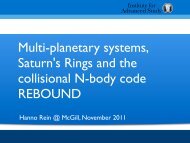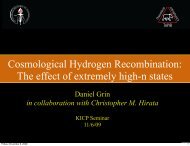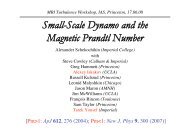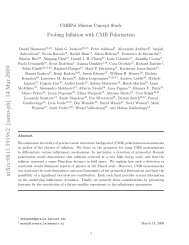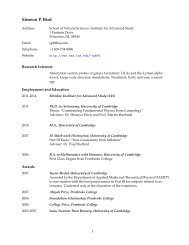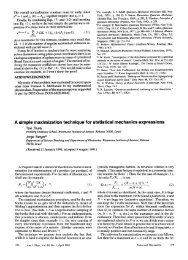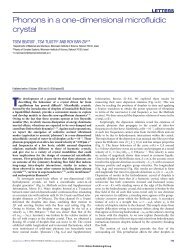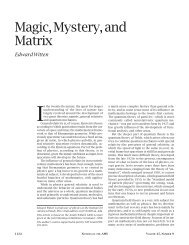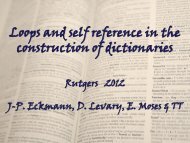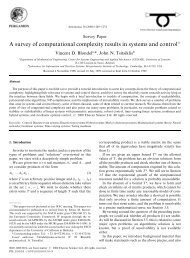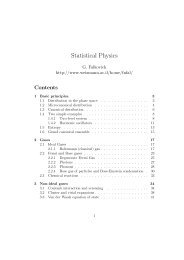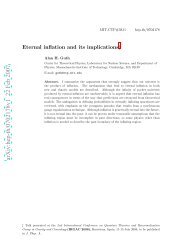Introduction to String Theory and D–Branes - School of Natural ...
Introduction to String Theory and D–Branes - School of Natural ...
Introduction to String Theory and D–Branes - School of Natural ...
You also want an ePaper? Increase the reach of your titles
YUMPU automatically turns print PDFs into web optimized ePapers that Google loves.
with a similar expression for ¯ Tghost(¯z). Just as before, as the ghosts are free fields, with equations <strong>of</strong> motion<br />
∂zc = 0 = ∂zb, we can Laurent exp<strong>and</strong> them as follows:<br />
∞<br />
b(z) = bn z −n−2 ∞<br />
, c(z) = cn z −n+1 , (163)<br />
n=−∞<br />
n=−∞<br />
which follows from the property that b is <strong>of</strong> weight 2 <strong>and</strong> c is <strong>of</strong> weight −1, a fact which might be guessed<br />
from the structure <strong>of</strong> the action (160). The quantisation yields<br />
<strong>and</strong> the stress tensor is<br />
L gh<br />
n =<br />
∞<br />
m=−∞<br />
{bm, cn} = δm+n . (164)<br />
(2n − m) : bmcn−m : −δn,0<br />
where we have a normal ordering constant −1, as in the previous sec<strong>to</strong>r.<br />
The OPE for the ghosts is given by<br />
(165)<br />
[L gh<br />
m , bn] = (m − n)bm+n , [L gh<br />
m , cn] = −(2m + n)cm+n . (166)<br />
b(z)c(y) =<br />
1<br />
+ · · · ,<br />
(z − y)<br />
1<br />
c(z)b(y) = + · · · ,<br />
(z − y)<br />
b(z)b(y) = O(z − y) , c(z)c(y) = O(z − y) , (167)<br />
where the second expression is obtained from the first by the anticommuting property <strong>of</strong> the ghosts. The<br />
second line also follows from the anticommuting property. There can be no non–zero result for the singular<br />
parts there.<br />
As with everything for the closed string, we must supplement the above expressions with very similar<br />
ones referring <strong>to</strong> ¯z, ¯c(¯z) <strong>and</strong> ¯ b(¯z). For the open string, we carry out the same procedures as before, defining<br />
everything on the upper half plane, reflecting the holomorphic in<strong>to</strong> the anti–holomorpic parts, defining a<br />
single set <strong>of</strong> ghosts.<br />
3.5.2 The Critical Dimension<br />
Now comes the fun part. We can evaluate the conformal anomaly <strong>of</strong> the ghost system, by using the techniques<br />
for computation <strong>of</strong> the OPE that we refined in the previous section. We can do it for the ghosts in as simple<br />
a way as for the ordinary fields, using the expression (162) above. In the following, we will focus on the most<br />
singular part, <strong>to</strong> isolate the conformal anomaly term. This will come from when there are two contractions<br />
in each term. The next level <strong>of</strong> singularity comes from one contraction, <strong>and</strong> so on:<br />
T gh (z)T gh (y)<br />
= (: ∂zb(z)c(z) : + : 2b(z)∂zc(z) :)(: ∂yb(y)c(y) : + : 2b(y)∂yc(y) :)<br />
= : ∂zb(z)c(z) :: ∂yb(y)c(y) : +2 : b(z)∂zc(z) :: ∂yb(y)c(y) :<br />
+ 2 : ∂zb(z)c(z) :: b(y)∂yc(y) : +4 : b(z)∂zc(z) :: b(y)∂yc(y) :<br />
= +2 <br />
+ 2 +4 <br />
= − 13<br />
, (168)<br />
(z − y) 4<br />
<strong>and</strong> so comparing with equation (146), we see that the ghost sec<strong>to</strong>r has conformal anomaly c = −26. A<br />
similar computation gives ¯c = −26. So recalling that the “matter” sec<strong>to</strong>r, consisting <strong>of</strong> the D bosons, has<br />
c = ¯c = D, we have achieved the result that the conformal anomaly vanishes in the case D = 26. This also<br />
applies <strong>to</strong> the open string in the obvious way.<br />
42



